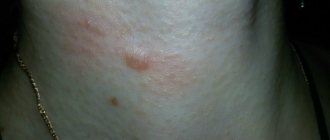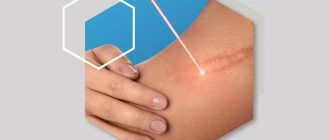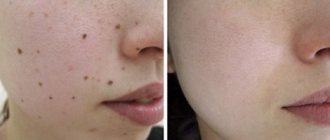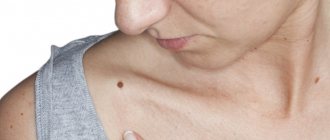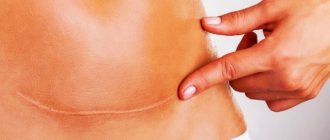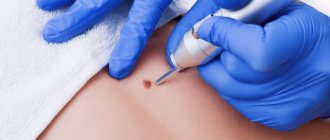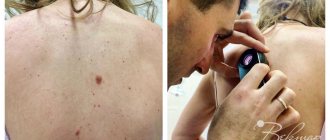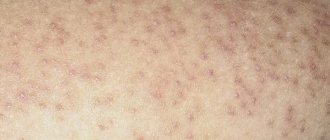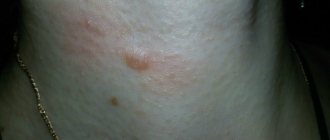What determines the risk of scarring?
The appearance of a scar and its nature depends on a number of factors:
- Depth and area of damage: if they are small, a scar may not appear at all.
- Tissue healing abilities.
- The presence of chronic diseases (for example, diabetes).
- Time for complete healing of the wound (it may increase if the wound has become infected).
The process of complete wound healing, which lasts for 21 days, ends with pathological scarring in only 33% of cases. If the process lasts more than 21 days, the probability increases to 78%.
Laser mole removal takes a long time to heal.
The healing time depends on the size of the mole, location, and individual characteristics of the regenerative processes.
If they are small in size, up to 0.5 cm, moles heal in 10-14 days; if they are larger than 1 cm, regeneration takes up to 3-4 weeks.
In places with good blood supply and in open areas of the body, healing is faster, up to 14 days. In places that are subject to friction (belt, bra line, groin area), get wet (perineum, armpits), have thick skin and poor blood flow (sole, palm), healing takes up to 4 weeks.
How does a wound heal?
The following phases of wound healing are distinguished:
- Inflammation. It begins immediately after the injury and lasts about 2-3 days, during this phase it is necessary to clean the wound and carry out anti-infective measures.
- Proliferation. From 3 days to 2 weeks. It is necessary to maintain the absence of infection and adequate hydration.
- The appearance of a scar. From 2 weeks to several years. During this phase, measures are taken to correct the scar depending on its type. [12]
Is a scar a reason to go to the doctor?
Reasons for visiting a doctor:
- aesthetic dissatisfaction;
- itching and pain in the scar area;
- the formation of deformities and contractures, which can lead to disability.
If scar tissue begins to develop pathologically and causes a keloid scar, it is better to consult a doctor.
There are factors that increase the risk of developing a scar:
- genetic predisposition;
- race (black patients are more likely to develop keloids);
- localization of injury (when removing tumors in the chest, neck and shoulders, the likelihood of keloid scars is higher);
- age (the formation of keloid scars is typical for young people)
How to prevent the appearance of a keloid scar?
There are several ways to prevent the appearance of a keloid scar.
- If surgical excision of the tumor is performed, techniques that minimize tension on the wound edges should be used during suturing.
- Mechanical stabilization - the use of special silicone plates or the use of silicone-based gels.
- The use of various medications containing flavonoids - substances obtained naturally from various plants (for example, onion extract). However, data on the effectiveness of this group of drugs is contradictory.
- Pressure therapy (compression) – within 15–40 mm Hg. Art. for 23 hours a day for 6 months. Data on the effectiveness of this method are also conflicting.
- Glucocorticosteroids (GCS) - can be used as creams or ointments in the initial stages of scar formation and to prevent its formation, as well as in the form of injections into scar tissue. [4]
How does laser mole removal work?
The procedure for removing moles is standard and includes several stages:
- Examination of the skin by a dermatologist to exclude the presence of signs of melanoma. There is a classification of 5 criteria for which the doctor must examine and check the formation. Shape, size, color, surrounding tissue, density. Sometimes dermatoscopy (examination of an element under multiple magnification) can be used for diagnosis. Having completely convinced that the formation is benign, the specialist begins the removal procedure itself.
- Consultation before the procedure. The dermatologist talks about how the procedure will take place and the symptoms that will accompany it. Possible complications and limitations that will occur after the manipulation.
- Signing the patient's informed consent for the administration of anesthetic and laser vaporization.
- Next, he proceeds directly to removing the mole. The area is treated with a skin antiseptic. An anesthetic injection is given. After complete freezing, the mole is removed within healthy tissue using a CO laser. Repeated treatment with a disinfecting solution is carried out.
- Recommendations for care.
What if a scar appears?
Once scar tissue has formed, unfortunately, it will not be possible to completely get rid of it. All medical actions in this case will be aimed at minimizing the manifestations of the scar. The following methods are used to treat formed keloids:
- GCS injections are a popular and effective method for treating keloid and hypertrophic scars. A GCS solution is injected into the scar tissue 1–2 times a month until the expected results appear. Unfortunately, with excessive use of the drug, skin atrophy may develop at the injection site, telangiectasia or an atrophic scar may appear. [4]
- Surgical excision of the scar - you should not resort to this method as the only remedy, since it always ends in a relapse that exceeds the existing scar in area. This method can be resorted to after previous long-term therapy carried out in various ways. [4]
- Cryotherapy is the treatment of scars with liquid nitrogen. There are various methods of its use: spray, contact method and intralesional cryoprobe. The latter method is more effective. In addition, the combination of cryotherapy with GCS injections gives the best result compared to others. [4]
- Laser treatment – various lasers are used. Nd:YAG laser with a wavelength of 1,064 nm is used to target the vessels of scar tissue. In addition, CO2 and Er:YAG lasers are actively used in fractional mode. But it is not recommended to use ablative lasers (CO2 and Er:YAG) as the only treatment method, since in this case there is a high probability of relapse. [5]
A dye laser (PDL) with a wavelength of 585 nm is also considered effective. [6]
There is evidence of the effective use of CO2 laser in fractional mode during surgery to improve the cosmetic outcome of healing. [7]
- Ointment with 5-fluorouracil for the treatment of scars, but it is not sold in Russia. [4]
- Botulinum toxin type A is used to weaken the tension of the wound edges by reducing muscle activity. Injections are given immediately after surgery. [8]
- Imiquimod cream is recommended for use after surgical excision of a scar to minimize the likelihood of recurrence. [9]
- Other methods - bleomycin, verapamil, TGF-β, interferon, tacrolimus, sirolimus, tamoxifen, epidermal growth factor, retinoic acid, tamoxifen and other drugs are also considered effective for the treatment of scars. [10]
Which method is the most effective?
Unfortunately, there is no most effective treatment for scars. The most effective is considered to be a combination of various methods, which is always selected individually. Injections of corticosteroids into hypertrophic or keloid scars are considered an accessible, effective and inexpensive method.
Atrophic scars are distinguished separately: for their correction, planar ablative lasers, fractional ablative lasers (CO2 and Er:YAG), various combinations of lasers (fractional +PDL, Qsw+fractional lasers), collagen, fillers with hyaluronic acid, PRP therapy, microneedling are used. , peeling and a number of other methods [11, 12]
Previously, the dermabrasion method was used to correct atrophic scars, but now it is practically not used, since it is associated with the risk of side effects: bacterial or viral complications, telangiectasia, hyperpigmentation, a long rehabilitation period, as well as hypertrophic or keloid scars.
Why you shouldn't sunbathe after mole removal
In the previous answer we partially answered the question. In the area of the epidermis that is not formed after laser removal, the risk of neoplasia (improper cell division) increases with the risk of developing cancer cells in the future. The second reason is the risk of age spots. The mechanism is almost the same. The weak, immature epidermis, trying to protect itself under the influence of sunlight, begins to actively produce the pigment melanin. This process goes faster than in nearby undamaged skin. Therefore, the intensity of skin coloring under the rays of the sun is different. A hyperpigmented area appears at the site where the mole was removed by laser.
How not to treat scars
Incorrect treatment, in addition to wasting money and time, can lead to enlargement of the scar. What could cause this:
- non-compliance with doctor’s recommendations after removal or self-medication;
- traumatization and irritation of the wound can lead to relapse;
- non-compliance with prescribed antiseptic methods;
- removal of the crust that has formed at the site of removal: under it the restoration process is more efficient.
There is not enough information in scientific sources to evaluate the effectiveness of folk remedies in the treatment of scars. From my experience I can say that I have not seen a single patient for whom folk remedies produced any significant positive changes. And in fairness, it’s worth saying that I rarely encounter the use of folk remedies in the treatment of scars.
Medical - advantages of ordering laser resurfacing
Our clinic uses advanced laser devices to quickly, effectively, painlessly eliminate scars after removing moles on the face. We provide professional consultations to patients, set reasonable prices for all types of minimally invasive treatments, use high-quality medications, and have extensive experience.
Make an appointment with us for a procedure for removing scars left from a nevus. Our experienced specialists will make your body beautiful by eliminating unwanted pigment spots. We are waiting for a call.
Bibliography:
- J Am Acad Dermatol. 2016 Apr; 74(4): 607–25; quiz 625–6. doi: 10.1016/j. jaad. 2015.08.070. Wound healing and treating wounds: Chronic wound care and management. Powers JG, Higham C, Broussard K, Phillips TJ.
- J Am Acad Dermatol. 2016 Apr; 74(4): 589–605; quiz 605–6. doi: 10.1016/j. jaad. 2015.08.068. Wound healing and treating wounds: Differential diagnosis and evaluation of chronic wounds. Morton LM, Phillips TJ.
- Ann Hum Genet. 2022 Feb 27. doi: 10.1111/ahg.12245. Gene-based evaluation of low-frequency variation and genetically-predicted gene expression impacting risk of keloid formation. Hellwege JN, Russell SB, Williams SM, Edwards TL, Velez Edwards DR.
- Int. J. Mol. Sci. 2022, 19(3), 711; doi: 10.3390/ijms19030711. Recent Understandings of Biology, Prophylaxis and Treatment Strategies for Hypertrophic Scars and Keloids. Ho Jun Lee, Yong Ju Jang.
- Br J Dermatol. 2011 Nov; 165(5): 934-42. doi: 10.1111/j.1365-2133.2011.10492.x. Laser and intense pulsed light therapy for the treatment of hypertrophic scars: a systematic review. Vrijman C, van Drooge AM, Limpens J, Bos JD, van der Veen JP, Spuls PI, Wolkerstorfer A.
- Laser Ther. 2013 Dec 30; 22(4): 255–260. doi: 10.5978/islsm.13-OR-20 Laser Scar Management Technique. Takafumi Ohshiro, Toshio Ohshiro, and Katsumi Sasaki
- Arch Dermatol. 2011 Sep;147(9):1108-10. doi: 10.1001/archdermatol.2011.248. A randomized split-scar study of intraoperative treatment of surgical wound edges to minimize scarring. Ozog DM, Moy RL.
- Plast Reconstr Surg. 2022 Mar;141(3):646-650. doi: 10.1097/PRS.0000000000004110. Effects of Botulinum Toxin on Improving Facial Surgical Scars: A Prospective, Split-Scar, Double-Blind, Randomized Controlled Trial. Hu L, Zou Y, Chang SJ, Qiu Y, Chen H, Gang M, Jin Y, Lin X.
- Curr Pharm Des. 2017;23(15):2268-2275. doi: 10.2174/1381612822666161025144434. The Effectiveness of Topical Anti-scarring Agents and a Novel Combined Process on Cutaneous Scar Management. Fang QQ, Chen CY, Zhang MX, Huang CL, Wang XW, Xu JH, Wu LH, Zhang LY, Tan WQ.
- Dermatol Surg. 2022 Jan; 43 Suppl 1:S3-S18. doi: 10.1097/DSS.0000000000000819. Keloids and Hypertrophic Scars: Pathophysiology, Classification, and Treatment. Berman B, Maderal A, Raphael B.
- Clinical and Experimental Dermatology, June 1, 2013. Combination of intense pulsed light and fractional CO2 laser treatments for patients with acne with inflammatory and scarring lesions. B. Wang, Y. Wu.
- Skinmed. 2022 Aug 1; 15(4):271-276. eCollection 2022. Techniques for Optimizing Surgical Scars, Part 1: Wound Healing and Depressed/Atrophic Scars. Konda S, Potter K, Ren VZ, Wang AL, Srinivasan A, Chilukuri S.
